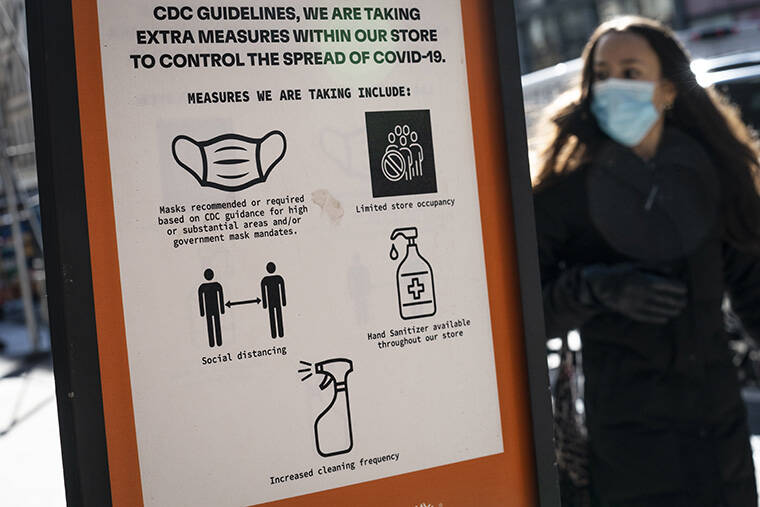
For months, some American and European leaders have foretold that the coronavirus pandemic would soon become endemic. COVID-19 would resolve into a disease that we learn to live with. According to several governors, it nearly has.
But we are still in the acute phase of the pandemic, and what endemic COVID-19 might look like remains a mystery. Endemic diseases can take many forms, and we do not know yet where this disease will fall among them.
At its most basic, an endemic disease is one with a constant, predictable or expected presence. It’s a disease that persists. Beyond that, there is no fixed definition.
Endemic diseases infect millions of people around the world each year, and some endemic diseases kill hundreds of thousands. Some we can treat and vaccinate against. Yet they can also cause unexpected outbreaks and significant suffering.
Interviews with two dozen scientists, public health experts and medical historians suggest the rush to recast COVID-19 as endemic may be missing the point.
“There’s been a political reframing of the idea of endemic as something that is harmless or normal,” said Lukas Engelmann, a historian of medicine and epidemiology at the University of Edinburgh. But epidemiologists use endemic to mean something we should watch carefully, he said, because an endemic disease can become epidemic again.
When people think of endemic disease, they often think of the common cold. Upper respiratory infections, including colds, are estimated to infect billions of people worldwide every year but kill several thousand. Other endemic diseases can be much more lethal. Malaria killed more than 600,000 people globally in 2019, and flu killed more than 200,000, though estimates suggest these tolls could be much higher.
Many scientists predict that endemic COVID-19 may have a burden similar to that of other respiratory viruses.
“It will be no more deadly than seasonal flu, or may be mild like one of the cold-causing coronaviruses,” said Lone Simonsen, director of the PandemiX Center at Roskilde University in Denmark.
“The reason for this is that we have a lot of immunity and we keep getting boosted from the infections that we run into,” she said.
Some scientists warn that immune protection from vaccination and infection may wane over time and that future variants might sidestep those defenses. And mutations are random, so there is always a chance a variant that causes more severe disease could arise in the future.
The common cold and the flu are widespread endemic diseases that persist year round, but their levels are not constant. Instead they cause seasonal epidemics, where infections rise beyond baseline endemic levels, often in the winter when people gather indoors.
These patterns are predictable, but people can change them: The control measures used to blunt the COVID pandemic dampened flu and cold waves in recent years, too. Scientists say that endemic COVID could be seasonal, but it could also have irregular and significant epidemic waves.
“COVID is much, much more transmissible than the flu,” said Jeffrey Shaman, an infectious-disease modeler at Columbia University. “Only a small portion of the population needs to be susceptible for an outbreak to foment, and that can happen at any time of year.”
One community’s experience with endemic disease can be vastly different from another’s, often depending on who is getting sick and whether they have access to tests, treatments and health care.
HIV, which has persisted across the globe for more than 40 years, is one example, though scientists and public health workers use both “epidemic” and “endemic” to describe the virus.
“One definition of endemic is defined by geographic location,” said Dr. Diane Havlir, an infectious disease specialist and professor of medicine at the University of California, San Francisco. “Through that lens, HIV is endemic in the United States, where approximately 1.2 million persons are living with HIV.”
“But HIV is epidemic in subpopulations in the U.S.,” she added.
Infectious diseases often remain in communities where poverty or discriminatory systems prevent access to health care, Havlir said.
“Disease disparities increase over time unless they are addressed at the outset,” she said. “And that raises the question: Are we addressing those disparities with COVID or are we on that same trajectory?”
With one-third of the global population unvaccinated against COVID and lifesaving treatments not available to all, the virus’s burden will probably continue to be unequal, experts say, even as parts of the world decide their levels are endemic.
Among the many forms endemic disease can take, one thing is clear: Endemic does not mean the end of the disease.
Instead, it means living with, and often managing, a disease that has not been, or cannot be, stamped out. Health experts say that countries must use control measures, like testing, treatments and vaccinations, to keep endemic diseases in check.
Countries with endemic malaria aspire to eradicate the mosquito-borne disease and rely on interventions like insecticides and preventive treatments to reduce its incidence. These control measures can drastically alter the course of endemic malaria, as they have in South Africa.
In addition to environmental controls, vaccination programs can reduce cases and deaths. But when communities do not adhere to vaccination recommendations, outbreaks can happen.
Measles, for example, remained endemic in the United States for 40 years after the introduction of vaccines. During that period, unvaccinated people remained vulnerable, fueling occasional outbreaks. In 2019, two decades after the disease was declared eliminated in the United States, several outbreaks, many associated with unvaccinated travelers, infected more than a thousand people.
Unlike malaria or measles, public health experts say, COVID cannot be eradicated, so control measures will help determine the size and course of future waves. (We have eradicated just one human disease: smallpox, which behaved quite differently from COVID.)
Keeping up with COVID means staying focused on vaccinating people, treating them and updating vaccines, said Dr. Monica Gandhi, an infectious disease specialist and professor of medicine at the University of California, San Francisco.
“It’s going to take constant vigilance to keep it — not to eradicate it, which would be what humans want — but to keep it under control,” Gandhi said.
Probably not for a while. Scientists usually determine a disease’s endemic pattern after observing it for many years. Pandemics can take years to settle, and the consequences of widespread illness can last long after new infections fade.
Much of what we know about the transition out of pandemics comes from flu: Humans have witnessed four influenza pandemics in the last 100 years. The 1918-19 pandemic, which killed more than 50 million people globally, dwarfs them all.
It took the 1918 flu pandemic three years to settle into a more regular pattern, and the United States had a significant 1920 wave that killed more people in some cities than previous waves had. In the years that followed, some seasonal outbreaks were larger than others.
The assumption about COVID’s endemic period is that it will look meaningfully different from the pandemic of the last two years. But endemic COVID, in the worst-case scenario, could look something like where we’ve been.
“You can imagine a situation where omicron-like events happen every year,” said Trevor Bedford, a virologist at the Fred Hutchinson Cancer Research Center in Seattle.
“That can be the endemic state,” Bedford said. “And it doesn’t mean that it’s mild, and it doesn’t mean that it’s easy to deal with.”
This article originally appeared in The New York Times.
Source: Star Ads





